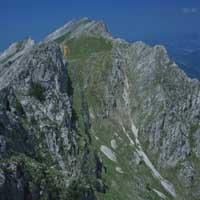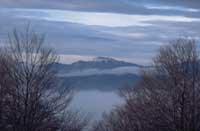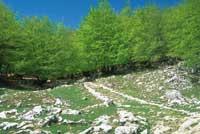Aizkorri Natural Park

It is known that the Aizkorri mountain range is located south of Gipuzkoa, bordering Navarre and Alava. Also known, especially among mountaineers, are the areas of Arantzazu, Urbia, San Adrián, Aizkorri, Aketegi, Aratz and surroundings.
Since the park declaration is pending execution, the scope of protected spaces cannot be accurately said, but it will not be limited only to the Aizkorri mountain range. In fact, it will include the most representative territories, landscapes and peaks of the surrounding area. For example, it occupies the territories of Gipuzkoa and Araba with an area of approximately 20,000 ha. It will include territories between the hills of Arlaban and Otzaurte. The following municipalities will be located in the Gipuzkoa area: Eskoriatza, Aretxabaleta, Leintz-Gatzaga, Oñati, Legazpi, Zerain and Zegama. From the Alaves, Asparrena and San Millán. In addition, the grounds of the Consortium of Gipuzkoa and Alava will be part of the Park.
Although, for many people, the highest peak of the CAPV is that of Aizkorri, in reality the highest peaks are Aitxuri (1,549 m) and Aketegi (1,548 m), and not Aizkorri (1,524 m). All these summits are located in the Aizkorri-Aloña mountain range and are well known. However, in the vicinity you can find less known and as beautiful mountains as the previous ones, such as those of Elgea and Urkilla.
Being a territory of great surface, in this protected environment we will find very heterogeneous landscapes and ecosystems, each with its characteristic vegetation and fauna. In general, and to explain it with a brief stroke, we will find on the one hand rich ecosystems associated with rivers and water areas. On the other hand, in these areas interesting forest communities can be observed and, finally, we will have unique ecosystems in the high summits. As for the vegetation, it is worth highlighting on the one hand the oak trees of the area of Barrendiola de Legazpi, without forgetting the acidophilous beech, much more abundant.

The list of animals that inhabit the forests, pastures and mountains of this park is endless, although it is worth highlighting the bravos of vultures, vultures, azores and hawks that breed in these areas. In recent years the royal eagle has also approached these lands, but you still can not know if it is grown in them. As for mammals, the lenses, catagueñas, mountain cats, roe deer and wild boars, which are inhabitants of the park, stand out.
It is clear that the natural value of this environment is abundant and that whoever is interested in knowing it will have, apart from these lines, the opportunity to deepen the subject, since, as usually happens in all natural parks, in the future there will be centers of interpretation and explanation.
However, in this park there are elements that, besides the natural aspects, cannot be discarded. For example, the cultural possibilities offered by these environments are important, sometimes related to the rural and religious environment. An example of this is the tourist offer of recent years in various localities of the area, such as the museums and ethnographic guided itineraries of Zerain, the iron museum of Legazpi, the salt flats of Leintz-Gatzaga, etc. These offers have come in many cases behind the impulse of agrotourism. Despite not being so new, in this park we will find, in turn, numerous cultural elements of religious court. The case of Arantzazu is perhaps the most prominent, attended by thousands of people every year. However, there are several hermitages and crosses scattered throughout the park.
On the other hand, we must not forget the living vestiges of an ancient profession that has lasted and lasts for centuries: yes, we talk about pastoralism. Who has never come to Urbia to taste native cheese? The megalithic remains of the Urbia and Degurixa camps are witnesses of this hard and ancient craft. It is not our intention to carry out in these lines an ethnographic study on grazing and grazing in these areas, but at present the influence of grazing on the life of these areas is still remarkable.

On the other hand, the landscape of some areas, such as Urbia and Degurixa, is indisputable that grazing is conditioned and shaped for centuries. Therefore, in the future of this economic activity the proper management of the park will be of vital importance. In any case, that sustainable balance that is so often mentioned and that nobody really knows what it is, would be the main objective.
They will also witness the different debates and opinions that arise to understand this balance. In fact, the wind farm that is intended to be built in the Cordillera de Elgea has generated in society conflicting opinions, and as mentioned above, this environment would enter the limits of the Park. The debate is already in the square, and time will show to what extent the protection of these environments can be combined with the development of our society, if before we all study late, where that balance is.
San Adrián road

This road, so close to the exit of the cave of San Adrián, is the most important historical road of Gipuzkoa. Over the centuries it passed through the main road linking the Castilian lands with France, Germany or Holland.
Also on this road passed the pilgrims who on their way to Santiago intended to avoid the lands of the Sakana, since the lands of the ravine were dangerous due to the abundance of bandits. However, these areas of San Adrián were not free of bandits and in these areas there are curious things related to thefts.
In the muga with Gipuzkoa and Araba, the road was divided into two, one on the left, towards Zalduondo and Araia, and the other on the right towards Galarreta. This
road has been considered numerous times as Roman, but, according to experts, has not ceased to be XI. It would be from the nineteenth century, coinciding with the construction of the chapel located inside the tunnel.
Buletina
Bidali zure helbide elektronikoa eta jaso asteroko buletina zure sarrera-ontzian











